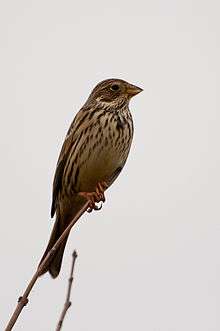Corn bunting
| Corn bunting | |
|---|---|
 | |
| In Jardin des Plantes, Paris, France | |
| Scientific classification | |
| Kingdom: | Animalia |
| Phylum: | Chordata |
| Class: | Aves |
| Order: | Passeriformes |
| Family: | Emberizidae |
| Genus: | Emberiza Brehm, 1831 |
| Species: | E. calandra |
| Binomial name | |
| Emberiza calandra (Linnaeus, 1758) | |
| Synonyms | |
|
Miliaria calandra | |
The corn bunting (Emberiza calandra) is a passerine bird in the bunting family Emberizidae, a group now separated by most modern authors from the finches, Fringillidae. It is usually placed in the genus Emberiza, but some taxonomists place it in the monotypic genus Miliaria.[2] The genus name Emberiza is from Old German Embritz, a bunting. The specific calandra is from Ancient Greek kalandros, the calandra lark.[3]
Description
This is an unusual bunting because the sexes appear similar in plumage, although the males are approximately 20% larger than females. This large bulky bunting is 16–19 cm long, with similar plumages for the male and female, and lacks the showy male colours, especially on the head, common in the genus Emberiza. Both sexes look something like larks, with streaked grey-brown above, and whitish underparts.
The song of the male is a repetitive metallic sound, usually likened to jangling keys, which is given from a low bush, fence post or telephone wires.
Distribution and habitat
It breeds across southern and central Europe, north Africa and Asia across to Kazakhstan. It is mainly resident, but some birds from colder regions of central Europe and Asia migrate southwards in winter.
The corn bunting is a bird of open country with trees, such as farmland and weedy wasteland. It has declined greatly in north-west Europe due to intensive agricultural practices depriving it of its food supply of weed seeds and insects, the latter especially when feeding young. It has recently become extinct in Ireland, where it was previously common.
Behaviour and ecology
Food and feeding
Its natural food consists of seeds and when feeding young, insects.
Breeding

Males defend territories in the breeding season and can be polygynous, with up to three females per breeding male. The population sex ratio is generally 1:1, which means some males remain unmated during a season. Males play only a small role in parental care; they are not involved in nest building or incubation, and only feed the chicks when they are over half grown.
The nest is made of grass, lined with hair or fine grass, and is usually built on the ground. Average clutch size is four, but commonly varies from three to five, occasionally six.
Status and conservation
In England, the government's environmental organisation Natural England offers grants towards implementing measures to conserve this species, under the environmental stewardship scheme.[4]
References
- ↑ BirdLife International (2012). "Miliaria calandra". IUCN Red List of Threatened Species. Version 2013.2. International Union for Conservation of Nature. Retrieved 26 November 2013.
- ↑ Allende, Luis M; Rubio I; Ruíz-del-Valle V; Guillén J; Martínez-Laso J; Ernesto L; Varela P; Zamora J; Arnaiz-Villena A. (2001). "The Old World Sparrows (Genus Passer) Phylogeography and Their Relative Abundance of Nuclear mtDNA Pseudogenes" (PDF). Journal of Molecular Evolution. 53 (2): 144–154. doi:10.1007/s002390010202. PMID 11479685.
- ↑ Jobling, James A. (2010). The Helm Dictionary of Scientific Bird Names. London, United Kingdom: Christopher Helm. pp. 84, 145. ISBN 978-1-4081-2501-4.
- ↑ Natural England Environmental Stewardship Scheme webpages
External links
| Wikimedia Commons has media related to the corn bunting. |
- BBC article with video about corn buntings
- ARKive stills and video
- Images of a male corn bunting singing from top of a flowering plant, Asphodelus, in Greece in springtime
- Oiseaux photos
- Ageing and sexing (PDF; 1.6 MB) by Javier Blasco-Zumeta and Gerd-Michael Heinze
- Feathers of corn bunting (Emberiza calandra)
